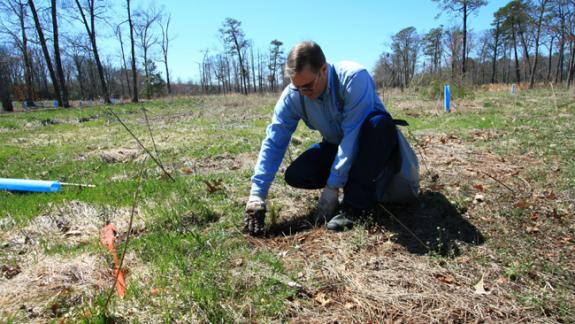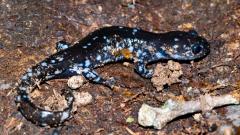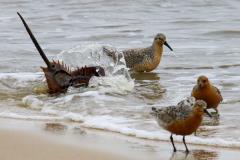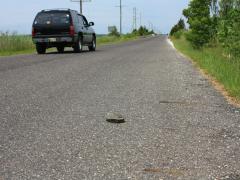Volunteer for Conserve Wildlife Foundation
Did you know that you can actually help spread the word to help protect the future of New Jersey's wildlife?
 A volunteer helps plant a tree seedling on an old fairway inside Cape Island WMA in 2010. © Ben Wurst
A volunteer helps plant a tree seedling on an old fairway inside Cape Island WMA in 2010. © Ben Wurst
Education and awareness are the key to the survival of rare wildlife and our conservation efforts.
Our programs and projects would not be successful without the help from dedicated volunteers throughout the state. From assisting with road closures to help amphibians safely cross roads, helping to fence beach nesting bird habitat, listening for frog and toad calls, monitoring American kestrel nestboxes, counting bats, and installing and repairing osprey nesting platforms, you can support us and help to conserve and monitor New Jersey's rare wildlife. Most of these volunteer opportunities offer chances to get hands-on experience with wildlife management techniques in the habitat where these rare species exist. You will discover that New Jersey is an amazing state that is rich in biodiversity. You will also meet other like-minded individuals who are passionate about wildlife conservation and are not afraid to get dirty!
Volunteer Opportunities
Click on a project to get more information on ways you can help.
- Amphibian Crossing Project
- Delaware Bay Shorebird Stewards
- Kestrel Nestbox Monitoring Project
- Great Bay Terrapin Steward
 | Volunteer ProfilesVolunteers are a very important part of wildlife conservation and management in New Jersey. Meet some of our valuable helpers. |
Volunteer Projects
 Zoom+ A Blue-spotted salamander. © George Cevera
Zoom+ A Blue-spotted salamander. © George Cevera
Geographic Area: Various Sites in Northern New Jersey
Time of year: March-April
Time commitment: 4-hour evening shifts plus training (usually 4 nights a year)
Duties: Volunteers needed to help move amphibians cross busy roadways in the evening and collect data.
The Conserve Wildlife Foundation has been partnering with NJ’s Endangered and Nongame Species Program (ENSP) since 2002 to protect early-spring breeding amphibians like the wood frog, spotted salamander, Jefferson salamander, and spring peeper during their annual migration. On peak nights each Spring, we work with a fleet of incredible volunteers to hustle amphibians across the road at rescue sites, collect data on the numbers and species seen, measure the impacts of vehicular traffic, and document additional amphibian crossings for future protection. A lovely article in the New York Times (April 2009) described our group as “chaperones to an amphibian dance.”
Click here for more information.
For more information, contact: Christine Healy, Wildlife Biologist: Email
 Zoom+ Red knots feeding at Pierce's Point @ Bill Reinert
Zoom+ Red knots feeding at Pierce's Point @ Bill Reinert
DELAWARE BAY SHOREBIRD STEWARDS
If you enjoy bird watching and the bay then this opportunity might be for you!
Part-time Shorebird Stewards are needed during May to protect critical shorebird beaches along the Delaware Bayshore. These include Villas beaches north to Reed’s Beach in Cape May County and Fortescue and Thompson's in Cumberland County.
Since 2003 Conserve Wildlife Foundation (CWF) shorebird stewards have been helping to protect shorebirds on nine closed beaches along the Delaware Bay in New Jersey. The shorebird stewards’ presence on the beaches is critical to the protection of the migrating birds including the endangered red knot. The CWF Shorebird Steward Program minimizes disturbance to shorebirds through outreach and education.
Shorebird stewards support beach restrictions by being present at restricted beaches during shorebird season to ensure that resting and foraging shorebirds are not disturbed. This job includes educating beach visitors as to why the beaches are closed and the importance of the beaches to horseshoe crabs and migrating shorebirds.
Stewards are need for the following dates in 2024: May 11 through May 27th. There are three shifts a day.
If you are interested in learning more about stewarding this shorebird season
Please contact Larissa Smith for more information: email
 Zoom+ Two-week-old kestrel chicks in a nestbox. © MacKenzie Hall
Zoom+ Two-week-old kestrel chicks in a nestbox. © MacKenzie Hall
KESTREL NESTBOX MONITORING PROJECT
Geographic Area: 3 Project Areas – Clinton Area (Hunterdon, Somerset Counties); Amwell Valley Area (Hunterdon, Mercer, Somerset Counties); Assunpink Area (Mercer, Monmouth Counties)
Time of Year: Spring (April, May, June, July)
Time Commitment: 3-5 hours every 2 weeks during the breeding season
Duties: Monitor a set of nestboxes to determine use and productivity by American kestrels. Volunteers will be assigned a group of boxes (between 12 and 20) to monitor every 12-15 days. Boxes are affixed to utility poles, trees, or buildings approximately 10-15 feet off the ground. Volunteers will need to have access to a vehicle capable of carrying a 16-foot aluminum ladder. Volunteers will climb ladder and observe boxes to determine occupancy of box by kestrels (or other wildlife species). Volunteers may need to add bedding, remove bedding, and/or destroy starling eggs. Data must be submitted online within 48 hours of nestbox checks.
Contact: Bill Pitts, NJDEP Fish & Wildlife at 856-629-5783
 Zoom+ From May - August hundreds of terrapins cross Great Bay Blvd. Slow down and allow them to cross or help in the direction they are traveling. © Ben Wurst
Zoom+ From May - August hundreds of terrapins cross Great Bay Blvd. Slow down and allow them to cross or help in the direction they are traveling. © Ben Wurst
GREAT BAY TERRAPIN STEWARDS
Geographic Area: Various roads in southern Ocean and Atlantic County
Time of year: June and early July
Time commitment: Any amount of time you can spare. Weekends are when more patrols are needed.
Duties: Volunteers are needed to help conduct road patrols in coastal areas where nesting female terrapins enter roadways.
Volunteers help educate the public about terrapins, our conservation efforts, and their threats in the environment. They record sightings of terrapins along Great Bay Blvd and other roads in suitable habitat. Data will be used to identify other road kill hot-spots. Volunteers also help terrapins safely cross roads. You can also collect injured and/or road-killed terrapins for egg harvesting and transportation to a local hatchery at the Tuckerton Seaport. Volunteers can also help maintain the terrapin fence along Great Bay Blvd.
Contact: Ben Wurst
 Zoom+ Horseshoe crab and eggs @L. Smith
Zoom+ Horseshoe crab and eggs @L. Smith
reTURN THE FAVOR
Geographic area: Delaware Bay Beaches, Pierce's Point, Cape May County.
Time of year: Mid-May- June
Time Commitment: attend a training to conduct walks yourself or join a CWF walk
CWF partners with Return The Favor and we are looking for volunteers to help flip stranded crabs on CWF's "adopted" beach, Pierce's Point. The Mission of Return the Favor is a collaborative effort that enables organized volunteers to save horseshoe crabs stranded on New Jersey’s seasonally closed and open beaches.
CWF Senior Biologist, Larissa Smith will lead some walks at Pierce's Point during the Horseshoe crab spawning season. Volunteers are also needed to sign up and go out on their own walks at Pierce's Point.
To get all the details on the Reutrn the Favor project and the upcoming trainings, please go to their website.
Any questions? contact Larissa.smith@conservewildlifenj.org




